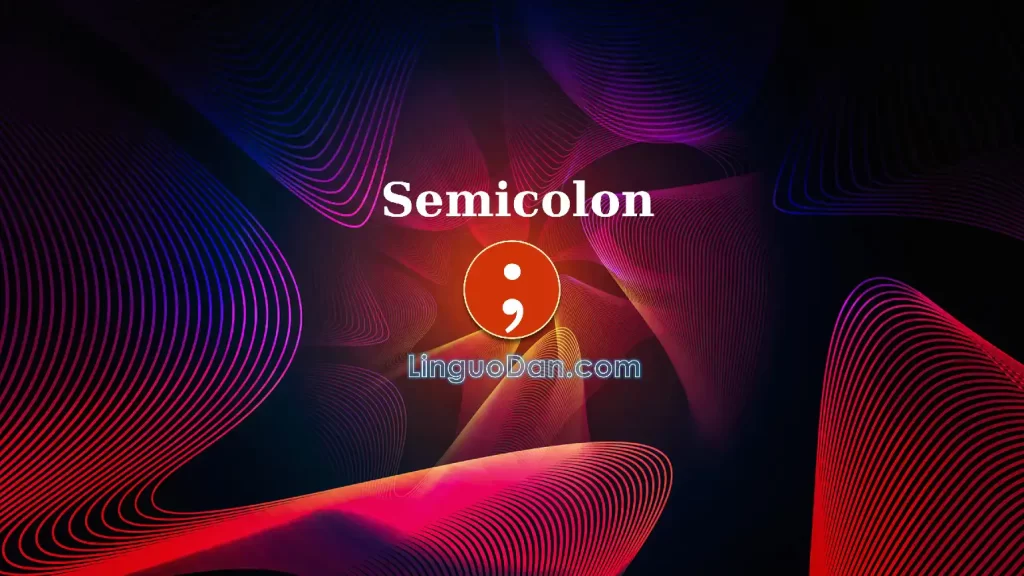Semicolons in English: rules and examples of use

Using Semicolons (;) – Guide, Rules and Examples
The semicolon (;) is a punctuation mark that is used to connect independent clauses within a single complex sentence. The semicolon is less common in English compared to commas or periods, but it signals a longer pause than a comma and a shorter pause than a period. The semicolon allows individual clauses to be joined into a cohesive whole, allowing for better presentation of the sentence’s meaning. In this article, we will look at the basic rules for using the punctuation mark – the semicolon – in English, along with examples of usage so that you can build and write sentences correctly.
Basic rules for using semicolons in English
Combining Independent Clauses Without a Conjunction
One of the main uses of the semicolon is to connect sentences that have a similar theme or topic. This allows you to replace a period and avoid the need for extra conjunctions like “and” or “but”. For example:
- Example: She finished the report; her colleague checked it for errors.
- Example: The weather is warm; summer is finally here.
Separating Items in a List
Semicolons are often used to separate items in a list when those items already contain commas, such as when enumerating cities and states. This helps prevent confusion and improves the clarity of the sentence structure.
- Example: My travel destinations this year include Paris, France; Rome, Italy; and Barcelona, Spain.
- Example: The conference attendees came from London, England; Berlin, Germany; and Rome, Italy.
Connecting Independent Clauses with Transition Words
When connecting independent clauses with transitional phrases like “however,” “therefore,” or “as a result,” a semicolon should come before the transition word to preserve proper grammar. A comma is then usually used after the transition word or phrase.
- Example: She excelled in the interview; consequently, she secured the job.
- Example: She was not feeling well; however, she decided to attend the meeting.
Clarifying Complex Lists
In complex lists where items contain commas, semicolons can be used to avoid confusion and clearly delineate each item.
- Example: The workshop covered topics like time management, a crucial skill for success; effective communication, an essential aspect of teamwork; and problem-solving, a key competency in professional settings.
Connecting Clauses with Conjunctions
Use a semicolon to connect independent clauses with similar content and a conjunction if the sentence could be confusing with just a comma.
- Example: She loves to travel, especially to exotic places; however, she hates flying.
Improving Readability
When two main clauses present a contrast or balance, a semicolon can be used to indicate the significance of the connection between them. This adds depth beyond just simple sentence construction.
- Example: Some people prefer dogs; others like cats.
Balancing Sentences
When you write two sentences that have an opposite or equal meaning, a semicolon helps show that the two sentences are related but not dependent on each other. For example:
- Example: The sunrise was breathtaking; the sunset was even more so.
Separating Participial Phrases
Semicolons can be used to separate participial phrases when they are used in complex constructions.
- Example: The book, which is on the top shelf, belongs to Sarah.
Clarifying Additional Information
A semicolon may be used to set off additional information that provides some clarification.
Example: The scientist, an expert in her field, conducted groundbreaking research.
Dividing Short Independent Clauses
Although less common, semicolons can also be used to divide short independent clauses if they are closely related in meaning.
- Example: The meeting ended early; everyone was pleased with the outcome.
As you can see from the rules, using semicolons in English is not overly complex. Semicolons connect independent clauses within a single complex sentence that are related in meaning, either without a conjunction or with one where a comma could be confusing. They are also used for making lists that already contain commas, like enumerating cities and states. Try testing yourself with the practice below.
Exercise 1: Combining Independent Clauses
Read the sentences. Determine how they relate to each other. Use a semicolon to combine these sentences to create a grammatically correct construction. Check your answers against the provided answers below.
- She enjoys hiking, she often explores the nearby trails.
- They visited the museum, they learned about ancient artifacts.
- I love reading, I find it relaxing.
- The sun was shining, the sky was clear.
- He enjoys playing chess, he participates in local tournaments.
Answers
- She enjoys hiking; she often explores the nearby trails.
- They visited the museum; they learned about ancient artifacts.
- I love reading; I find it relaxing.
- The sun was shining; the sky was clear.
- He enjoys playing chess; he participates in local tournaments.
Exercise 2: Connecting Independent Clauses with Transition Words
Read the sentences. Determine if there is a logical connection between them. Select an appropriate transition word or phrase (e.g., “however,” “therefore,” “consequently,” “moreover”) to connect the sentences. Use a semicolon before the transition phrase. Check your answers against those provided below.
- The movie was interesting she fell asleep during it.
- The weather was hot they decided to go for a swim.
- She wanted to go out it was raining heavily.
- He studied hard for the exam he passed it successfully.
- The show was entertaining they stayed until the end.
Answers
- The movie was interesting; however, she fell asleep during it.
- The weather was hot; therefore, they decided to go for a swim.
- She wanted to go out; however, it was raining heavily.
- He studied hard for the exam; consequently, he passed it successfully.
- The show was entertaining; so, they stayed until the end.